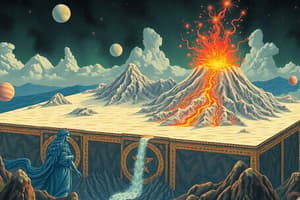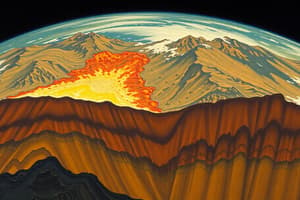Podcast
Questions and Answers
What type of volcano is characterized by its broad, gently sloping sides, formed by low-viscosity lava flows?
What type of volcano is characterized by its broad, gently sloping sides, formed by low-viscosity lava flows?
- Stratovolcano
- Shield (correct)
- Cinder Cone
- Composite
Which of the following is TRUE about a caldera?
Which of the following is TRUE about a caldera?
- It is a type of volcanic vent that releases lava and ash.
- It is a small, cone-shaped depression formed at the summit of a volcano.
- It is created by the collapse of a volcano's magma chamber after a large eruption. (correct)
- It is a large, underground igneous rock body.
Which of the following is NOT a type of igneous intrusion?
Which of the following is NOT a type of igneous intrusion?
- Dike
- Sill
- Laccolith
- Fault (correct)
Which of the following best describes the difference between elastic and plastic deformation?
Which of the following best describes the difference between elastic and plastic deformation?
Which of the following is the primary driving force behind the movement of tectonic plates?
Which of the following is the primary driving force behind the movement of tectonic plates?
What is the relationship between magma viscosity and the type of volcanic eruption?
What is the relationship between magma viscosity and the type of volcanic eruption?
Which of the following best describes the condition under which a reverse fault occurs?
Which of the following best describes the condition under which a reverse fault occurs?
Which type of seismic wave travels the fastest?
Which type of seismic wave travels the fastest?
What is the primary cause of a strike slip fault?
What is the primary cause of a strike slip fault?
Which seismic wave is most likely to cause significant damage to buildings and structures?
Which seismic wave is most likely to cause significant damage to buildings and structures?
What is the difference between the focus and the epicenter of an earthquake?
What is the difference between the focus and the epicenter of an earthquake?
How does the moment magnitude scale differ from the Mercalli scale in measuring earthquakes?
How does the moment magnitude scale differ from the Mercalli scale in measuring earthquakes?
Flashcards
Ridge Push
Ridge Push
A force that pushes tectonic plates apart at mid-ocean ridges due to newly formed, elevated oceanic crust.
Slab Pull
Slab Pull
A force that pulls tectonic plates downward at subduction zones due to the sinking edge of a plate.
Caldera
Caldera
A large, bowl-shaped depression formed at the summit of a volcano due to the collapse of ground after magma chamber empties.
Magma Viscosity
Magma Viscosity
Signup and view all the flashcards
Cinder Cone Volcano
Cinder Cone Volcano
Signup and view all the flashcards
Composite Volcano
Composite Volcano
Signup and view all the flashcards
Elastic Deformation
Elastic Deformation
Signup and view all the flashcards
Reverse Fault
Reverse Fault
Signup and view all the flashcards
Strike Slip Fault
Strike Slip Fault
Signup and view all the flashcards
Seismic Waves
Seismic Waves
Signup and view all the flashcards
Types of Seismic Waves
Types of Seismic Waves
Signup and view all the flashcards
Focus vs Epicenter
Focus vs Epicenter
Signup and view all the flashcards
Moment Magnitude Scale
Moment Magnitude Scale
Signup and view all the flashcards
Study Notes
Plate Tectonics: Ridge Push and Slab Pull
- Ridge push: Newly formed, elevated oceanic crust at mid-ocean ridges pushes plates apart.
- Slab pull: The denser, sinking edge of a plate at a subduction zone pulls the rest of the plate downward.
Volcanic Features: Caldera
- Caldera: A large, bowl-shaped depression formed at a volcano's summit when the magma chamber empties during an eruption, causing the ground above to collapse.
Volcano Types
- Cinder Cone: Small, steep cone-shaped volcanoes composed of ash, cinders, and rock fragments from a single eruption.
- Shield Volcano: Broad, gently sloping sides formed by low-viscosity lava flows.
- Composite Volcano: Steep-sided, mountain-like volcanoes composed of layers of lava, ash, and rock with frequent explosive eruptions.
Magma Viscosity
- Viscosity: Magma viscosity is determined by silica content; high silica content results in thick, high-viscosity magma; low silica content generates thin, low-viscosity magma.
Eruption Types and Volcanoes
- High Viscosity Magma: Thick magma; leads to explosive eruptions; associated with composite volcanoes.
- Low Viscosity Magma: Thin magma; leads to quiet eruptions; associated with shield volcanoes.
Igneous Intrusions
- Dike: A vertical igneous intrusion that cuts across rock layers.
- Sill: A horizontal igneous intrusion that occurs between rock layers.
- Laccolith: A dome-shaped intrusion that pushes rock layers upward.
- Batholith: A massive underground igneous rock body, larger than 100 square kilometers.
Stress on Rocks
- Compression: Squeezes rocks together, causing folding or breakage; common at convergent boundaries.
- Tension: Pulls rocks apart, causing thinning and fractures; common at divergent boundaries.
- Shear: Moves rocks past each other in opposite directions, leading to twisting or faulting; common at transform boundaries.
Rock Deformation
- Elastic Deformation: A temporary change in shape or size that is reversible when stress is removed.
- Plastic Deformation: A permanent change in shape or size that is not reversible even after stress is removed.
Fault Types
- Reverse Fault: Caused by compression; the hanging wall moves up relative to the footwall.
- Normal Fault: Caused by tension; the hanging wall moves down relative to the footwall.
- Strike-Slip Fault: Caused by shear; rocks on either side of the fault move horizontally past each other.
Seismic Waves
- Seismic waves: Waves of energy that travel through the Earth's layers, caused by energy release during earthquakes.
Seismic Wave Types
- P-waves: Fastest waves; compressional waves moving back and forth.
- S-waves: Slower waves; shear waves moving side to side.
- Surface waves: Slowest waves; travel along the surface; cause significant damage with rolling or side-to-side motion.
Focus and Epicenter
- Focus (hypocenter): The point inside the Earth where an earthquake originates.
- Epicenter: The point on the Earth's surface directly above the focus.
Seismometer Function
- Seismometer: Detects and measures seismic waves using a suspended mass on a spring. The mass stays stationary while the frame connected to the ground moves, recording the vibrations.
Earthquake Measurement Scales
- Moment Magnitude Scale: Measures total energy released based on fault size, slip amount, and rock type. Provides a precise scientific measurement.
- Mercalli Scale: Measures earthquake intensity based on observed effects (people, buildings). More subjective and varies by location.
Studying That Suits You
Use AI to generate personalized quizzes and flashcards to suit your learning preferences.




